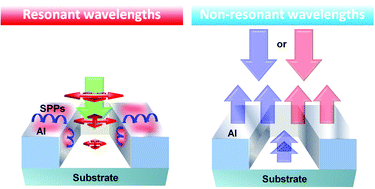Filter-free, junctionless structures for color sensing†
Abstract
A simple structure, efficient color splitting, sufficient output of electrical signals, and low power consumption are the important characteristics of contemporary devices for color sensing. In this study, we developed filter-free, junctionless structures that exhibited a superior photo-thermo-electrical response under a low bias voltage and a short response time in milliseconds. Although our compact sensor had a simple single-layer trench-like aluminum (Al) structure, it could perform multiple functions, including light harvesting, color-selective absorption, photo-thermo-electrical transformation, and the ability to collect photoinduced differences in electrical signals. This device exploited near-field surface plasmon resonance and cavity effects to enhance the intensity of the electric field and the color-selective absorption, ultimately resulting in significant current signals in its structured Al film. This strategy significantly simplifies not only the components of the color sensor but also its fabrication; for example, red, green, and blue color detection devices could be prepared simultaneously through a single lithography, etching, and deposition step. With its ability to provide functional filter-free, junctionless structures, this strategy has great potential for the production of devices that operate on different kinds of substrates, thereby bridging various applications of color sensing technologies.


 Please wait while we load your content...
Please wait while we load your content...